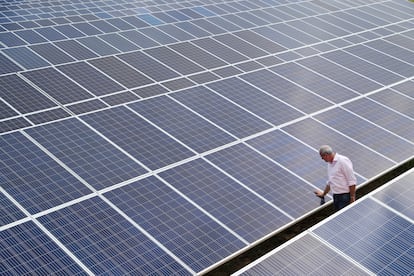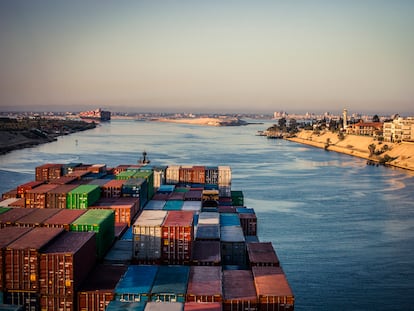Latin America could set a global example for a just energy transition
By 2030, 70% of the region’s electricity could come from renewable sources

In Latin America and the Caribbean, a mix of technological, economic, social and political factors could come together to ensure that the region has the right conditions to become a global example of a just energy transition. The Renewables in Latin America and the Caribbean (RELAC) initiative, signed by 15 countries, established that by 2030, 70% of the region’s electric energy consumption would come from renewable sources. The goal is attainable.
According to 2020 statistics from the the World Bank, around 20% of the world’s population lives in 70 countries with excellent conditions for photovoltaic energy, where daily averages exceed 4.5 kilowatt hours/kilowatt peak (kWh/kWp, measures of yield and production), enough to boil about 25 liters of water. The Latin American countries that fall into this category are Chile, Peru, Mexico and Argentina. The rest of Latin America is not far behind, though: in the range of 3.5- 4.5 kWh/kWp. In terms of wind power potential, Chile and Colombia lead the way.
This wealth of resources has translated into an accelerated rate of investment in the region in recent years. In 2019, Brazil, Mexico and Chile were part of the 20 countries in the world with the highest investment in renewable energy capacity. More recently, installed renewable energy capacity in Latin America and the Caribbean totaled 291,770 megawatts (MW) at the end of 2021, which represented a 6% increase compared to 2020. At the end of 2021, South America had an installed capacity of 244,975 MW, representing 84% of the total installed capacity in the region. In the last 10 years, the countries with the highest growth from renewable energy were Chile with 111%, Uruguay with 101%, Mexico with 99% and Brazil with 66%.
All this has been accompanied by advances in the regulation of different types of energy. Offshore wind energy in Colombia allowed it to be incorporated into the World Alliance for offshore wind energy; it is currently the only country in the region to form part of the Alliance. Additionally, the current and future installed capacity of renewable energies make Latin America an area with high potential for the generation of green hydrogen. This can be used as energy in the industrial sector, one of the most difficult to power, as well as in transportation and in the powering and heating of buildings. Several countries, such as Chile, Uruguay, Paraguay and Colombia, have already published their green hydrogen roadmaps.
These investments can help the region promote the progressive and responsible decarbonization of its economy. It can advance in both energy and economics at the same time. The just energy transition is an opportunity to align financial flows with the Paris Agreement – the most important climate treaty at the international level – including the treatment of subsidies, tax reforms, the promotion of savings and investments in clean energies. Additionally, according to data from the International Labor Organization, if the world manages to limit the increase in global temperature to 2°C by the end of the century, it could create 15 million more net jobs in Latin America and the Caribbean by 2030, thanks to changes in the food and energy sectors.
However, each country will advance at a different rate. For those that do not depend economically on the extraction of fossil fuels, as is the case for El Salvador, Honduras, Nicaragua, Costa Rica, Panama, Paraguay and Uruguay, the process will be easier.
Although a just energy transition may be on its way, it is important to avoid repeating the mistakes of the past. According to the Environmental Justice Atlas, which maps global cases of socio-environmental conflicts, more than half of these are related to the development of infrastructure in the energy sector, as well as the extraction of minerals and hydrocarbons. With Escazú Agreement now in force in several Latin American countries, access to participation processes and clear, truthful and timely information can provide more guarantees in the development of energy transition projects. This will help to demonstrate the alignment of governments and the private sector with environmental policies that, among other benefits, allow them to access new credits.
Likewise, several countries in the region, including Guatemala, Belize, Honduras, Costa Rica, Colombia, Suriname and Chile, have already included just energy transition legislation in their international climate commitments. That legislation opens up the potential to strengthen policy frameworks at the sectoral level. To accelerate investment in the technology transition, robust policies and regulatory frameworks are necessary. Particularly important regulations include those of energy storage systems and grid reliability; energy efficiency policies and standards; targeted demand for green hydrogen in energy expansion plans; and behavior change aimed at long-term impact.
According to the Energy Transition Index (ETI), Latin America and the Caribbean performs better than the world average in energy system performance, environmental sustainability, and capital and investment. Consequently, it is considerably better in energy infrastructure. In order to reduce the disparity of development among countries, investments must be distributed throughout the region.
There are still 17 million people who lack access to electricity in the region, mainly in Central America, where the demand for energy is expected to continue growing in the coming decades. This is an opportunity for the players in the clean energy sector to focus their resources on creating a cleaner and fairer energy matrix. The transition cannot be limited only to technology. It must also occur in the way that energy is produced and consumed, finding a balance between natural resources and society.
Tu suscripción se está usando en otro dispositivo
¿Quieres añadir otro usuario a tu suscripción?
Si continúas leyendo en este dispositivo, no se podrá leer en el otro.
FlechaTu suscripción se está usando en otro dispositivo y solo puedes acceder a EL PAÍS desde un dispositivo a la vez.
Si quieres compartir tu cuenta, cambia tu suscripción a la modalidad Premium, así podrás añadir otro usuario. Cada uno accederá con su propia cuenta de email, lo que os permitirá personalizar vuestra experiencia en EL PAÍS.
¿Tienes una suscripción de empresa? Accede aquí para contratar más cuentas.
En el caso de no saber quién está usando tu cuenta, te recomendamos cambiar tu contraseña aquí.
Si decides continuar compartiendo tu cuenta, este mensaje se mostrará en tu dispositivo y en el de la otra persona que está usando tu cuenta de forma indefinida, afectando a tu experiencia de lectura. Puedes consultar aquí los términos y condiciones de la suscripción digital.
More information
Archived In
Últimas noticias
There is as much life left to discover on planet Earth as that which is already known
Dozens presumed dead, around 100 injured in fire at Swiss Alps bar during New Year’s celebration
Is porn for women different from conventional porn? We spoke to those who make it
Cartagena de Indias is sinking: What can the city do to mitigate it?
Most viewed
- Reinhard Genzel, Nobel laureate in physics: ‘One-minute videos will never give you the truth’
- Sinaloa Cartel war is taking its toll on Los Chapitos
- David King, chemist: ‘There are scientists studying how to cool the planet; nobody should stop these experiments from happening’
- Oona Chaplin: ‘I told James Cameron that I was living in a treehouse and starting a permaculture project with a friend’
- The Interoceanic Train, the Mexican alternative to the Panama Canal










































